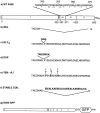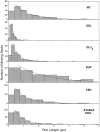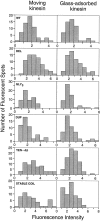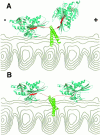Role of the kinesin neck region in processive microtubule-based motility
- PMID: 9508773
- PMCID: PMC2132664
- DOI: 10.1083/jcb.140.6.1407
Role of the kinesin neck region in processive microtubule-based motility
Abstract
Kinesin is a dimeric motor protein that can move along a microtubule for several microns without releasing (termed processive movement). The two motor domains of the dimer are thought to move in a coordinated, hand-over-hand manner. A region adjacent to kinesin's motor catalytic domain (the neck) contains a coiled coil that is sufficient for motor dimerization and has been proposed to play an essential role in processive movement. Recent models have suggested that the neck enables head-to-head communication by creating a stiff connection between the two motor domains, but also may unwind during the mechanochemical cycle to allow movement to new tubulin binding sites. To test these ideas, we mutated the neck coiled coil in a 560-amino acid (aa) dimeric kinesin construct fused to green fluorescent protein (GFP), and then assayed processivity using a fluorescence microscope that can visualize single kinesin-GFP molecules moving along a microtubule. Our results show that replacing the kinesin neck coiled coil with a 28-aa residue peptide sequence that forms a highly stable coiled coil does not greatly reduce the processivity of the motor. This result argues against models in which extensive unwinding of the coiled coil is essential for movement. Furthermore, we show that deleting the neck coiled coil decreases processivity 10-fold, but surprisingly does not abolish it. We also demonstrate that processivity is increased by threefold when the neck helix is elongated by seven residues. These results indicate that structural features of the neck coiled coil, although not essential for processivity, can tune the efficiency of single molecule motility.
Figures




Similar articles
-
Controlling kinesin by reversible disulfide cross-linking. Identifying the motility-producing conformational change.J Cell Biol. 2000 Nov 27;151(5):1081-92. doi: 10.1083/jcb.151.5.1081. J Cell Biol. 2000. PMID: 11086009 Free PMC article.
-
Processivity of the motor protein kinesin requires two heads.J Cell Biol. 1998 Mar 23;140(6):1395-405. doi: 10.1083/jcb.140.6.1395. J Cell Biol. 1998. PMID: 9508772 Free PMC article.
-
Demonstration of coiled-coil interactions within the kinesin neck region using synthetic peptides. Implications for motor activity.J Biol Chem. 1997 Apr 4;272(14):8946-56. doi: 10.1074/jbc.272.14.8946. J Biol Chem. 1997. PMID: 9083016
-
Mechanism of processive movement of monomeric and dimeric kinesin molecules.Int J Biol Sci. 2010 Nov 3;6(7):665-74. doi: 10.7150/ijbs.6.665. Int J Biol Sci. 2010. PMID: 21060728 Free PMC article. Review.
-
Structural links to kinesin directionality and movement.Nat Struct Biol. 2000 Jun;7(6):456-60. doi: 10.1038/75850. Nat Struct Biol. 2000. PMID: 10881190 Review.
Cited by
-
Autoinhibition regulates the motility of the C. elegans intraflagellar transport motor OSM-3.J Cell Biol. 2006 Sep 25;174(7):931-7. doi: 10.1083/jcb.200605179. J Cell Biol. 2006. PMID: 17000874 Free PMC article.
-
Processive movement of single kinesins on crowded microtubules visualized using quantum dots.EMBO J. 2006 Jan 25;25(2):267-77. doi: 10.1038/sj.emboj.7600937. Epub 2006 Jan 12. EMBO J. 2006. PMID: 16407972 Free PMC article.
-
A conserved tyrosine in the neck of a fungal kinesin regulates the catalytic motor core.EMBO J. 2003 Feb 3;22(3):450-8. doi: 10.1093/emboj/cdg036. EMBO J. 2003. PMID: 12554646 Free PMC article.
-
Mechanism of cooperative behaviour in systems of slow and fast molecular motors.Phys Chem Chem Phys. 2009 Jun 28;11(24):4890-8. doi: 10.1039/b900968j. Epub 2009 May 11. Phys Chem Chem Phys. 2009. PMID: 19506764 Free PMC article.
-
The complex interplay between the neck and hinge domains in kinesin-1 dimerization and motor activity.Mol Biol Cell. 2005 Aug;16(8):3529-37. doi: 10.1091/mbc.e04-11-0957. Epub 2005 May 18. Mol Biol Cell. 2005. PMID: 15901834 Free PMC article.
References
-
- Amos LA, Hirose K. The structure of microtubule-motor complexes. Curr Opin Cell Biol. 1997;9:4–11. - PubMed
-
- Arnal I, Metoz F, DeBonis S, Wade RH. Three-dimensional structure of functional motor proteins on microtubules. Curr Biol. 1996;6:1265–1270. - PubMed
-
- Berliner E, Young EC, Anderson K, Mahtani H, Gelles J. Failure of a single-headed kinesin to track parallel to microtubule protofilaments. Nature. 1995;373:718–721. - PubMed
-
- Block SM. Fifty ways to love your lever: myosin motors. Cell. 1996;87:151–157. - PubMed
-
- Block SM, Goldstein LS, Schnapp BJ. Bead movement by single kinesin molecules with optical tweezers. Nature. 1990;348:348–352. - PubMed

